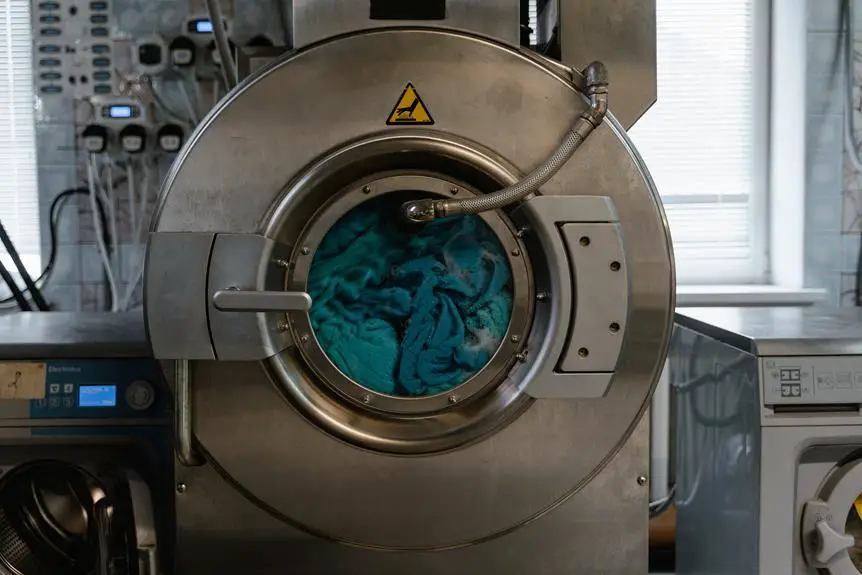Are you aware that 60% of laundry mishaps involve color bleeding or staining on red and white fabrics? If you've encountered this issue, you may be wondering if there's a way to salvage your clothing.
Fortunately, there are effective methods to restore the vibrancy of your red and white fabrics after a laundry mishap. By understanding the nature of the mishap, assessing the damage, and implementing specialized stain removal techniques, you can increase the likelihood of saving your garments.
This guide will provide you with the necessary steps to address the issue and revive your red and white fabrics to their former glory.
Key Takeaways
- Sort your laundry carefully according to color and fabric type to prevent color bleeding.
- Use cold water and a color-catching laundry sheet when washing red and white fabrics together.
- Test a small, inconspicuous area of the fabric with a color-safe bleach alternative before washing.
- Pre-treat stains immediately by blotting the stained area and applying a pre-treatment solution.
Understanding the Laundry Mishap
You can often avoid a laundry mishap by carefully separating red and white fabrics before washing. Understanding fabric care is crucial in preventing laundry accidents.
Red and white fabrics, especially those that are new or haven't been washed before, have a high chance of bleeding color if not properly cared for. To prevent this, sort your laundry carefully according to color and fabric type.
When washing red and white fabrics together, use cold water and a color-catching laundry sheet to absorb any color that may bleed. It's also important to turn the garments inside out to minimize friction and reduce the likelihood of color transfer.
Additionally, consider using a gentle detergent specifically formulated for colored fabrics. By taking these precautions and understanding the specific needs of your red and white fabrics, you can minimize the risk of a laundry mishap and keep your clothes looking fresh and vibrant.
Assessing the Damage
After understanding the laundry mishap, it is important to assess the damage to your red and white fabrics. Fabric assessment involves carefully examining each item to determine the extent of the damage and the potential salvage options. Below is a table to help you assess the damage and decide on the best course of action.
| Fabric | Damage Description | Salvage Options |
|---|---|---|
| Red Shirt | Faded color | Use fabric dye to restore the color |
| White Towels | Pink discoloration spots | Soak in a solution of vinegar and water to remove the pink hue |
| Red Dress | Shrunken and misshapen | Attempt to stretch and reshape using a fabric conditioner |
Assessing the damage allows you to strategize the best ways to salvage your red and white fabrics. Keep in mind that some damages may be irreversible, but with the right salvage options, you can potentially restore the appearance and functionality of your favorite items. Once you have assessed the damage and decided on salvage options, you can proceed with the necessary steps to restore your fabrics.
Pre-Treating Stains and Color Bleeds
To tackle stains and color bleeds, you'll need effective pre-treatment techniques. This includes methods like using specialized stain removers and color-safe bleaches.
Stain Removal Techniques
When dealing with stains and color bleeds on red and white fabrics, it's essential to pre-treat them using specific techniques to prevent permanent damage.
Start by testing a small, hidden area of the fabric with the stain remover to ensure it won't cause discoloration.
For colored stains, apply a stain remover directly to the affected area and gently rub it in. Allow it to sit for a few minutes before washing as usual.
For color bleeds, soak the fabric in a mixture of cold water and oxygen-based bleach, following the product's instructions. Avoid using hot water as it can set the dye.
After pre-treating, wash the fabric separately and check for any remaining stains before drying.
These fabric care techniques will help you effectively tackle stains and color bleeds caused by laundry accidents.
Color-Bleed Prevention Methods
Prevent color bleeds and stains on red and white fabrics by pre-treating them with specific techniques before washing.
To safeguard your fabrics, sort them by color and fabric type before washing. Use cold water and a gentle cycle to minimize color bleeding.
Prior to washing, test a small, inconspicuous area of the fabric with a color-safe bleach alternative to ensure it won't cause discoloration.
For red fabrics, add a cup of vinegar to the wash to help set the dye and prevent bleeding. Additionally, consider using color-catching sheets or detergents specifically formulated for color protection.
When dealing with stains, address them promptly using fabric-friendly stain removers.
Fabric-Saving Tips
Fabric preservation requires careful pre-treatment to mitigate potential stains and color bleeds, ensuring the longevity of your red and white fabrics.
To restore fabric and preserve colors, start by pre-treating any stains immediately. Gently blot the stained area with a clean cloth, working from the outside in to prevent spreading. Then, apply a pre-treatment solution directly to the stain and let it sit for the recommended time.
For color preservation, sort your laundry by color and wash red and white fabrics separately to prevent color bleeding. Additionally, consider using color-catching sheets in the wash to trap loose dyes.
Selecting the Right Washing Method
When selecting the right washing method for red and white fabrics, it's essential to use color-safe detergent to prevent color bleeding.
Remember to carefully follow the care label instructions for temperature and cycle selection to maintain the fabric's integrity.
Color-Safe Detergent Usage
Selecting the right washing method involves using color-safe detergent to preserve the vibrancy of red and white fabrics. When dealing with red and white fabrics, it's crucial to opt for a color-safe detergent to prevent color bleeding and fading. Look for detergents specifically formulated for colored fabrics and follow the manufacturer's guidelines for usage.
Sort your laundry carefully, washing red and white items separately to avoid color transfer. Additionally, consider using a gentle or delicate cycle to minimize friction and stress on the fabrics. Always measure the detergent according to the recommended amount to prevent overuse.
Temperature and Cycle Selection
To ensure the preservation of your red and white fabrics, carefully consider the temperature and cycle selection when choosing the right washing method. When dealing with red and white fabrics, it's crucial to pay attention to the water temperature and cycle type to prevent any further damage. Here's a guide to help you make the best decision:
| Fabric Type | Water Temperature | Cycle Selection |
|---|---|---|
| Red Fabrics | Cold or Warm | Gentle Cycle |
| White Fabrics | Cold or Warm | Delicate Cycle |
Applying Specialized Stain Removal Techniques
You can effectively remove tough stains from red and white fabrics by using specialized stain removal techniques. Follow these steps to restore your fabrics and prevent future stains:
- Identify the stain type: Different stains require different treatment. For example, protein-based stains like blood or sweat should be treated with cold water, while oil-based stains like grease or makeup require a different approach.
- Test the cleaning solution: Before applying any stain removal product, test it on a small, inconspicuous area of the fabric to ensure it doesn't cause discoloration or damage.
- Use the right technique: Depending on the type of stain and fabric, techniques such as blotting, soaking, or using a stain remover pen may be the most effective.
- Follow care label instructions: Always adhere to the care label instructions on your fabric to prevent damaging it further. Some fabrics may require special considerations such as dry cleaning or air-drying.
Ensuring Proper Drying and Finishing
After washing your red and white fabrics, carefully follow the care label instructions for proper drying and finishing. Proper handling and fabric protection during this stage are crucial to ensure the longevity and integrity of your fabrics. To help you navigate this process, here are some key tips to consider:
| Proper Drying | Proper Finishing |
|---|---|
| Air dry delicate fabrics to prevent shrinking and damage. | Iron fabrics at the appropriate temperature setting to avoid scorching or discoloration. |
| Use a gentle, low-heat setting when using a dryer to prevent excessive wear and tear. | Fold or hang fabrics neatly to prevent wrinkles and creases. |
| Avoid over-drying, which can lead to fabric weakening and loss of shape. | Allow fabrics to cool down before storing to prevent moisture buildup and mildew. |
Frequently Asked Questions
Can Red and White Fabrics Be Saved if the Colors Have Bled Onto Each Other?
If colors bled onto each other, red and white fabrics can be saved with proper fabric restoration. Act promptly. Wash in cold water, using color-safe bleach or vinegar. Avoid heat. Seek professional help if needed.
How Can I Prevent Color Bleeding in the Future?
To prevent color bleeding and preserve colorfast fabrics in the future, sort laundry by color and wash similar shades together. Use cold water and add a color catcher sheet to the load. Check garment labels for specific care instructions.
Are There Any Special Laundry Detergents or Products That Can Help Restore the Colors of Red and White Fabrics?
To restore colors of red and white fabrics, try specialized detergents or color restoration techniques. Look for products designed to preserve and enhance colors. Follow care labels and use cold water to prevent color bleeding.
Can I Use Bleach to Try and Salvage the Colors of My Red and White Fabrics?
Avoid using bleach on red and white fabrics to salvage colors. Instead, consider using vinegar or color-safe bleach to prevent color bleeding. Restoring colors without professional help may be possible with the right products and techniques.
Is It Possible to Reverse the Effects of Color Bleeding on Red and White Fabrics Without Professional Help?
You can attempt DIY methods to restore color in red and white fabrics. Natural remedies like vinegar and salt may help with color bleeding. However, for severe cases, professional help might be necessary for effective restoration.
- The History and Evolution of Chamois Fabric - June 22, 2025
- Chamois Fabric on Wikipedia: What You Need to Know - June 22, 2025
- How to Pronounce Chamois Fabric Correctly - June 22, 2025






